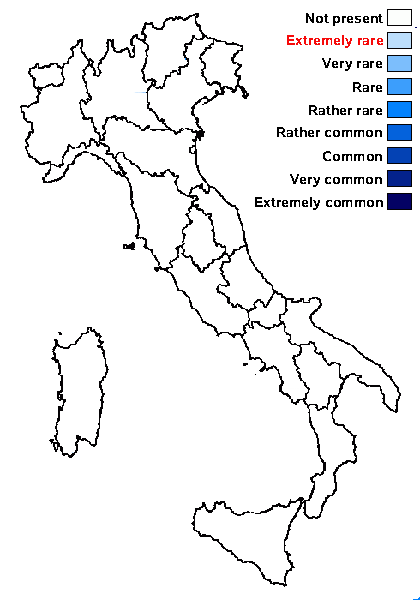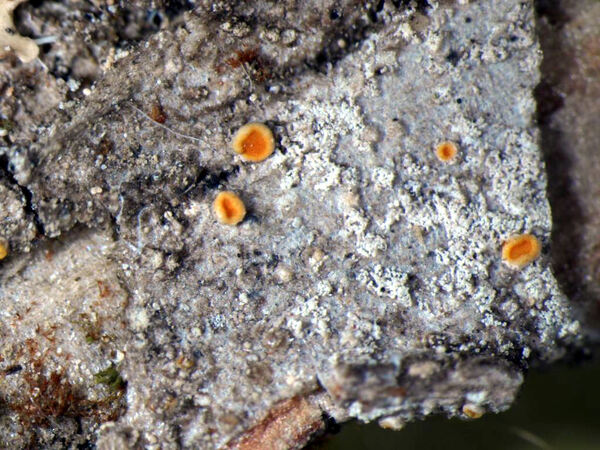Coppinsiella substerilis (Vondrák, Palice & van den Boom) S.Y. Kondr. & Lőkös
in Kondratyuk & al., Acta Bot. Hung., 60, 3-4: 383, 2018 Typification Details: Holotype CBFS, Vondrák 7920. Basionym: Caloplaca substerilis Vondrák, Palice & van den Boom - in Vondrák & al., Lichenologist, 45: 715, 2013.
Synonyms:
Distribution:
Description: Thallus crustose, endosubstratic or thinly episubstratic, 100-150 µm thick, continuous to rimose-areolate, rarely almost subsquamulose, pale grey to white, epruinose, sorediate, forming extensive patches, without a distinct prothallus. Soralia ellipsoid, up to 0.2 mm long, not crater-like, formed in tiny cracks of tree bark or on the margins and lower surface of the areoles, finally sometimes contiguous and forming a more or less continuous sorediate crust. Soredia greenish or greenish grey, (15-)23-26(-30) µm in diam. often gathered into (30-)37-46(-65) µm wide consoredia, the surface of soredia (and often also of thallus) papillate, with up to 7 µm high hyphal outgrowths. True cortex absent; alveolate cortex developed in patches, up to 20 µm thick, of thin-walled, more or less spherical cells; epinecral layer indistinct; medulla indistinct or absent. Apothecia rather rare, biatorine or zeorine, mostly up to 0.5 mm across, with an orange to orange-red disc, and a yellow-orange to orange, usually somewhat paler proper margin; thalline margin (when visible) yellow to white, sometimes sorediate. Exciple 40-80 µm wide, formed of a 30-70 µm wide proper exciple and an up to 30 µm wide thalline exciple; epithecium orange-brown, K+ purple-red; hymenium colourless, without extracellular oil drops, 60-70 µm high, I+ blue; paraphyses 1.5-2 µm thick in lower part, the uppermost cells (3.5-)4.5-5(-5.5) µm wide; hypothecium colourless, up to 100 µm high, extending downward through the subhypothecial algal layer. Asci 8-spored, clavate, functionally unitunicate, apically thickened with a broad internal beak, the inner part of apex and external cap I+ blue, Teloschistes-type. Ascospores 2-celled, polarilocular, hyaline, ellipsoid, (10-)12-14(-16.5) x (5-)7.5-8(-10-5) µm, the equatorial thickening (“septum”) (4-)4.5-6(-8.5) µm. Pycnidia rather frequent, with yellow tips containing anthraquinones. Conidia usually bacilliform, straight or slightly curved, rarely ellipsoid or tear-shaped, (2.5-)3-4(-5_0) x 1-1.3(-1.5) µm. Photobiont chlorococcoid. Spot tests: thallus K-, C-, KC-, P-. Apothecia and pycnidia K+ purple-red, C-. Chemistry: thallus without lichen substances; apothecia and pycnidia with non-chlorinated anthraquinones.
Note: on nutrient-rich bark in rather continental areas. Never reported from Italy, but known from the Alps and to be looked for there.
Growth form: Crustose
Substrata: bark
Photobiont: green algae other than Trentepohlia
Reproductive strategy: mainly asexual, by soredia, or soredia-like structures (e.g. blastidia)
Commonnes-rarity: (info)
Alpine belt: absent
Subalpine belt: absent
Oromediterranean belt: absent
Montane belt: absent
Submediterranean belt: absent
Padanian area: absent
Humid submediterranean belt: absent
Humid mediterranean belt: absent
Dry mediterranean belt: absent

Predictive model
Growth form: Crustose
Substrata: bark
Photobiont: green algae other than Trentepohlia
Reproductive strategy: mainly asexual, by soredia, or soredia-like structures (e.g. blastidia)
Commonnes-rarity: (info)
Alpine belt: absent
Subalpine belt: absent
Oromediterranean belt: absent
Montane belt: absent
Submediterranean belt: absent
Padanian area: absent
Humid submediterranean belt: absent
Humid mediterranean belt: absent
Dry mediterranean belt: absent

Predictive model
 INDEX FUNGORUM
INDEX FUNGORUM
 GBIF
GBIF



